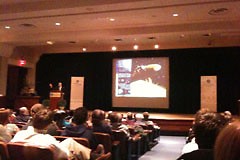Do aliens exist? And if so, when will we meet them?
These questions were on the mind of more than 200 science fans sitting (and standing) last night in Grand Valley State University's downtown Loosemore Auditorium (401 W. Fulton) as they listened to Dr. Seth Shostak lecture on the topic: “When will we find the extra terrestrials?”
Dr. Shostak is the author of the recent memoir Confessions of an Alien Hunter: A Scientist’s Search for Extraterrestrial Intelligence and is the Senior Astronomer at the Search for Extraterrestrial Intelligence Institute (SETI). The SETI Institute, as popularized by the Carl Sagan novel-turned-feature-film Contact, is a nonprofit organization that seeks to find evidence of intelligent life in outer space. He is the host of SETI’s weekly radio show Are We Alone? as well as the monthly program Skeptical Sunday, which is dedicated to “de-bunking pseudo-science” such as UFO-sightings. Additionally, as part of his position at SETI, Shostak is a primary point of outreach between the institution and the public. According to his bio on SETI’s website, Shostak gives more than 50 public lectures annually for both academic and general audiences.
Shostak spoke for just over two hours on the likelihood of intelligent life, how those beings might present themselves, and how soon we will likely find them. Shostak’s ability to connect with general audiences was evident in the many jokes peppered throughout the talk, at one point comparing planets to kittens because they always come in litters.
Shostak spent the majority of his lecture providing a historical context for the current search for extraterrestrial intelligence as well as what he believes to be an overwhelming probability that intelligent alien life exists. Shostak, who uses the working definition of “if you can build a radio transmitter” to explain intelligent life, posits that because the universe contains over 100 billion galaxies each with 100 billion stars—½ - ¾ of which have "litters" of planets orbiting around them—it is statistically improbable for extraterrestrial life not to have developed somewhere on the approximately one trillion other planets in the Milky Way. Furthermore, it is likely that such life would be intelligent, and because of the age of the universe relative to that of the Earth, alien life may have a head-start on human development.
“The universe is old enough to have truly deep intelligences,” Shostak said.
Though he believes it is probable, Shostak was quick to remind the audience that, as yet, “we have not found compelling evidence for intelligent life outside of earth.”
Shostak asserts that it’s unlikely that intelligent space dwellers are currently aware that earthlings exist because we have been broadcasting radio, television, and radar signals for a relatively short time, and the furthest signal has made it only about 60 light years away, well within the confines of our own galaxy.
That said, Shostak believes we will find evidence of intelligent extraterrestrial life and within short order.
He concluded his talk by expounding on the likelihood that when we do come into contact with intelligent beings from another planet, it may be in the form of “machine intelligence” (A.K.A. robots), and possibly within the next two dozen years.
The talk was broadcast over the Internet, and during the half-hour question-and-answer period, Dr. Shostak fielded questions primarily from the audience in the room, but from faraway locales like Norway and Australia as well. Shostak made a point of inviting skeptics in the room to speak, but he was not taken up on the offer.
Hunter Bridwell, a 22 year-old photography major at Kendall College of Art and Design, attended the lecture to find scientific reasoning for the existence of alien life. "I have watched those awful History Channel shows that are on in the middle of the day about alien abductions and strange things in the sky with intrigue but much skepticism," Bridwell said. "Those shows always leave you with no actual answer to whether or not there are little green men probing us. I wanted to get a better understanding as to what we do to find out about extraterrestrials."
The event was sponsored by the GVSU Physics Department, who were on hand after the lecture to give several physics demonstrations.
***UPDATE The slides, audio, and internet chat transcript are now available to view online here.
The Rapidian, a program of the 501(c)3 nonprofit Community Media Center, relies on the community’s support to help cover the cost of training reporters and publishing content.
We need your help.
If each of our readers and content creators who values this community platform help support its creation and maintenance, The Rapidian can continue to educate and facilitate a conversation around issues for years to come.
Please support The Rapidian and make a contribution today.


Comments
well if those ET's are so high fallutin' edumacted, i reckon they'll NOT be watching for the TV signals from Planet Earth!
Though they might find their way to the Rapidian..."irkgrnrnd glrtec!" is alien for "Hey the UICA has a new exhibit!"
I'd like to think that alien life would take at least some kind of cultural fascination with earthling tv signals. I mean, they are fascinating!